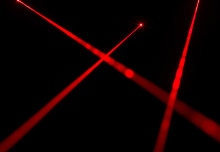Jan 30 2019
For the first time, light beams have been used by researchers to control lipid rafts in artificial cell membranes.
 Image credit: Shutterstock, Imperial College London
Image credit: Shutterstock, Imperial College London
Lipid rafts are domains (or areas) of protein and lipid (fats) which can be found floating at will in cell membranes—the protein and lipid layer that encloses a cell.
These rafts, which float in the membranes like icebergs, play critical but strange roles in cellular signaling that are still not totally explained.
However, thus far, the ability to examine them has been incomplete—mainly because we have not been able to move or exploit them.
A new study from Imperial College London has currently proven that optical tweezers, the laser-based technology that was awarded the 2018 Nobel Prize in Physics, can move, melt, scatter, and crystallize artificially made lipid rafts when beamed at artificial cell membranes. These artificial rafts were developed to imitate the lipid rafts in biological cell membranes.
The researchers say their discovery could help enhance their knowledge of the role of lipid rafts in critical biological processes such as communication and their connection to disease.
These light tweezers have illuminated a new path of research. Now we have the power to manipulate lipid rafts, we can discover so much more.
Dr Yuval Elani, Study Lead Author, Department of Chemistry, Imperial College of London
The study has been published in Nature Communications Chemistry.
Lighting the way
To perform the research, the scientists developed artificial cell membranes comprising of lipid rafts on glass slides. Under a microscope, optical tweezer lasers were beamed at the membranes.
When they turned on the laser and moved the beam, they learned the lipid rafts moved with them.
They also directed the laser’s heat straight onto the rafts to melt them, which caused them to scatter into smaller pieces. Then, they switched off the laser to discover the scattered pieces combined together again in a crystal-like shape.
Dr Elani said: “We altered the laser’s power to deliver different levels of heat of the system, and could melt domains which had different melting temperature due to their different lipid composition. This is a quick and easy way to determine the melting temperature of domains.”
Dr Elani added: “Optical tweezers have previously been used to study a host of cellular processes – from the folding of proteins, to the action of ribosomes and manipulating whole cells. Our technologies pave the way for a deep understanding of the underlying biophysics of lipid rafts and domains, and of their biological significance.”
In 2018, Arthur Ashkin won the Nobel Prize in Physics for using optical tweezers to grab particles, atoms, molecules, and living cells with their laser beam ‘fingers’. Now we have discovered yet more functions of these fascinating light beams.
Oscar Ces, Study Co-Author and Professor, Department of Chemistry, Imperial College of London
The authors say they will have to build new hardware to gather deeper understanding into how lipid rafts affect disease, but immediately, they will apply the method to biological membranes—ones that are not artificial.
They expect that the next stage of their study will further enhance the understanding of these enigmatic lipid rafts.
Manipulate and Mix/Demix
Video credit: Yuval Elani, Imperial College London